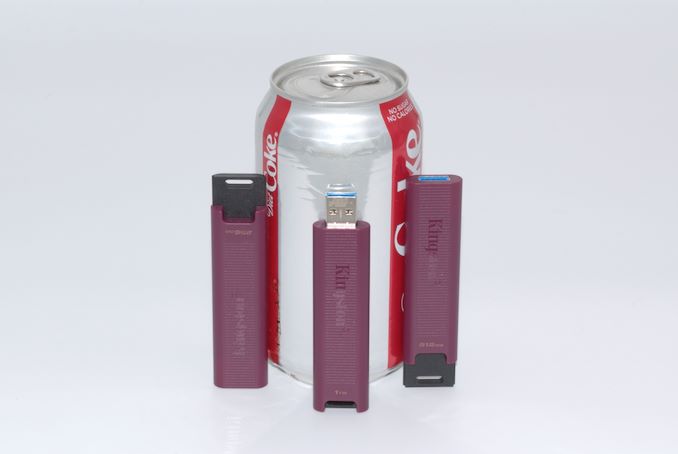
Kingston DataTraveler Max UFD Series Review: New Type-A Thumb Drive Retains NVMe Performance
2022-07-11Kingston’s new products in the portable flash-based external storage space have met with good market reception over the last year or so. Two products in particular – the Kingston XS2000 and the DataTraveler Max – continue to remain unique in the market with no other comparable products being widely available.
The XS2000 remains the only portable SSD with a USB 3.2 Gen 2×2 (20Gbps) interface equipped with a native flash controller (that brings cost and power-efficiency benefits over bridge-based solutions). The Kingston DataTraveler Max USB flash drive (UFD) – another product with a native flash controller – was introduced in August 2021. It advertised 1GBps-class speeds, low power consumption, and a Type-C interface – all in a thumb drive form-factor. Today, Kingston is expanding the DT Max series with three new drives – all sporting a USB 3.2 Gen 2 Type-A interface.
This review digs into all the three capacity points – 256GB, 512GB, and 1TB – in the new DTMAXA series sampled by Kingston. We’ll be taking a look at the performance, power efficiency, and value proposition of the DTMAXA. We’ve also cracked the drive open in order to determine differences between the hardware in the original DT Max and the new DTMAXA products.
Bus-powered external storage devices have grown both in storage capacity and speeds over the last decade. Thanks to rapid advancements in flash technology (including the advent of 3D NAND and NVMe) as well as faster host interfaces (such as Thunderbolt 3 and USB 3.2 Gen 2×2), the market has seen the introduction of palm-sized flash-based storage devices capable of delivering 2GBps+ speeds.
The thumb drive form factor is attractive for multiple reasons – there is no separate cable to carry around, and the casing can be designed to include a keyring loop for portability. Vendors such as Corsair and Mushkin briefly experimented with SATA SSDs behind a USB bridge chip, but the thermal solution and size made the UFDs slightly unwieldy. The introduction of high-performance native UFD controllers last year from Phison and Silicon Motion has made this category viable again.
Kingston’s DT Max series retains the traditional DataTraveler thumb drive form-factor. However, it takes full advantage of the USB 3.2 Gen 2 connector by promising 1GBps speeds. Available in three capacities – 256GB, 512GB, and 1TB, and in both Type-C and Type-A connector versions, Kingston says that they can deliver those high speeds across all six SKUs. We had done a thorough investigation into the 1TB capacity point of the DT Max Type-C version last year. Kingston claims that the new Type-A additions to the DT Max series are the same as the corresponding Type-C ones in terms of performance, capacity, and form factor, except for minor changes to the color and Type-A connector. We set out to confirm those claims.
The new Type-A series shares the same sliding cap design to protect the connector. The blue LED power indicator and keyring loop are retained. The new connector makes it necessary to slightly lengthen the UFD and also adds a couple of grams to the weight – specifics in the table at the end of this section.
The teardown process was similar to that of the Type-C version. With no screws in the design, everything is held by small plastic tabs. Other than the connector change, the only difference we could spot on the board was the updated flash package part number. While last year’s Type-C version used the FPxxx08UCM1-7D (with Micron’s 96L 3D TLC), the new DTMAX series uses the FBxxx08UCT1-AF (with Toshiba’s BiCS5 112L 3D TLC). It is not clear whether newer production runs of the Type-C versions have also shifted the flash parts – we can only comment on our review samples. Kingston continues to retain the Silicon Motion SM2320 native UFD controller.
Since the publication of our DataTraveler Max Type-C review, we have processed a number of different drives with our updated testbed and test suite. For comparison purposes, we have chosen a number of 1TB and smaller-sized direct-attached storage (DAS) devices.
CrystalDiskInfo provides a quick overview of the capabilities of the internal storage device. Since the program handles each bridge chip / controller differently, and the SM2320 has not yet found its way into the tracked controllers, many of the entries are marked as vendor-specific, and some of the capabilities (such as the interface) are deciphered incorrectly. The temperature monitoring worked well, though – just like it did for the Type-C version.
| S.M.A.R.T Passthrough – CrystalDiskInfo | |
 |
 |
The table below presents a comparative view of the specifications of the different storage bridges presented in this review.
| Comparative Direct-Attached Storage Devices Configuration | ||
| Aspect | ||
| Downstream Port | Native Flash | Native Flash |
| Upstream Port | USB 3.2 Gen 2 Type-A (Male) | USB 3.2 Gen 2 Type-C (Male) |
| Bridge Chip | Silicon Motion SM2320 | Silicon Motion SM2320 |
| Power | Bus Powered | Bus Powered |
| Use Case | 1GBps-class, compact USB thumb drive with retractable cover for Type-A connector | 1GBps-class, compact USB thumb drive with retractable cover for Type-C connector |
| Physical Dimensions | 91.2 mm x 22.3 mm x 9.5 mm | 82.6 mm x 22.3 mm x 9.5 mm |
| Weight | 14.5 grams | 12.5 grams |
| Cable | N/A | N/A |
| S.M.A.R.T Passthrough | Yes | Yes |
| UASP Support | Yes | Yes |
| TRIM Passthrough | Yes | Yes |
| Hardware Encryption | Not Available | Not Available |
| Evaluated Storage | Toshiba BiCS5 112L 3D TLC | Micron 96L 3D TLC |
| Price | USD 180 | USD 180 |
| Review Link | Kingston DTMAXA/1TB Review | Kingston DT Max 1TB Review |
Prior to looking at the benchmark numbers, power consumption, and thermal solution effectiveness, a description of the testbed setup and evaluation methodology is provided.
Testbed Setup and Evaluation Methodology
Direct-attached storage devices (including thumb drives) are evaluated using the Quartz Canyon NUC (essentially, the Xeon / ECC version of the Ghost Canyon NUC) configured with 2x 16GB DDR4-2667 ECC SODIMMs and a PCIe 3.0 x4 NVMe SSD – the IM2P33E8 1TB from ADATA.
The most attractive aspect of the Quartz Canyon NUC is the presence of two PCIe slots (electrically, x16 and x4) for add-in cards. In the absence of a discrete GPU – for which there is no need in a DAS testbed – both slots are available. In fact, we also added a spare SanDisk Extreme PRO M.2 NVMe SSD to the CPU direct-attached M.2 22110 slot in the baseboard in order to avoid DMI bottlenecks when evaluating Thunderbolt 3 devices. This still allows for two add-in cards operating at x8 (x16 electrical) and x4 (x4 electrical). Since the Quartz Canyon NUC doesn’t have a native USB 3.2 Gen 2×2 port, Silverstone’s SST-ECU06 add-in card was installed in the x4 slot. All non-Thunderbolt devices are tested using the Type-C port enabled by the SST-ECU06.
The specifications of the testbed are summarized in the table below:
| The 2021 AnandTech DAS Testbed Configuration | |
| System | Intel Quartz Canyon NUC9vXQNX |
| CPU | Intel Xeon E-2286M |
| Memory | ADATA Industrial AD4B3200716G22 32 GB (2x 16GB) DDR4-3200 ECC @ 22-22-22-52 |
| OS Drive | ADATA Industrial IM2P33E8 NVMe 1TB |
| Secondary Drive | SanDisk Extreme PRO M.2 NVMe 3D SSD 1TB |
| Add-on Card | SilverStone Tek SST-ECU06 USB 3.2 Gen 2×2 Type-C Host |
| OS | Windows 10 Enterprise x64 (21H1) |
| Thanks to ADATA, Intel, and SilverStone Tek for the build components | |
The testbed hardware is only one segment of the evaluation. Over the last few years, the typical direct-attached storage workloads for memory cards have also evolved. High bit-rate 4K videos at 60fps have become quite common, and 8K videos are starting to make an appearance. Game install sizes have also grown steadily even in portable game consoles, thanks to high resolution textures and artwork. Keeping these in mind, our evaluation scheme for portable SSDs and UFDs involves multiple workloads which are described in detail in the corresponding sections.
- Synthetic workloads using CrystalDiskMark and ATTO
- Real-world access traces using PCMark 10’s storage benchmark
- Custom robocopy workloads reflective of typical DAS usage
- Sequential write stress test
In the next section, we have an overview of the performance of the Kingston DTMAXA drives in these benchmarks. Prior to providing concluding remarks, we have some observations on the UFD’s power consumption numbers and thermal solution also.
Benchmarks such as ATTO and CrystalDiskMark provide a quick look at the performance of the direct-attached storage device. The results translate to the instantaneous performance numbers that consumers can expect for specific workloads, but do not account for changes in behavior when the unit is subject to long-term conditioning and/or thermal throttling. Yet another use of these synthetic benchmarks is the ability to gather information regarding support for specific storage device features that affect performance.
Synthetic Benchmarks – ATTO and CrystalDiskMark
Kingston claims read and write speeds of 1000 MBps and 900 MBps respectively for the DTMAX series. While the 1TB DTMax Type-C managed to hit that in the ATTO benchmarks, our chosen workloads don’t see the DTMAXA SKUs hitting it – not even in the 1TB version. Writes top out around 650 MBps, while the reads do go close to 1000 MBps. ATTO benchmarking is restricted to a single configuration in terms of queue depth, and is only representative of a small sub-set of real-world workloads. It does allow the visualization of change in transfer rates as the I/O size changes. Even though screenshots are not shown here, setting the ATTO benchmark’s queue depth to 8 (instead of the 4 we usually use) allows the numbers in the graph to go beyond even Kingston’s advertised claims. That said, it is evident that the DT Max Type-C 1TB we evaluated last year is not exactly the same performance-wise as the new DTMAXA/1TB.
| ATTO Benchmarks | |
| TOP: | BOTTOM: |
 |
|
 |
|
CrystalDiskMark. for example, uses four different access traces for reads and writes over a configurable region size. Two of the traces are sequential accesses, while two are 4K random accesses. Internally, CrystalDiskMark uses the Microsoft DiskSpd storage testing tool. The ‘Seq128K Q32T1’ sequential traces use 128K block size with a queue depth of 32 from a single thread, while the ‘4K Q32T16’ one does random 4K accesses with the same queue configuration, but from multiple threads. The ‘Seq1M’ traces use a 1MiB block size. The plain ‘Rnd4K’ one uses only a single queue and single thread . Comparing the ‘4K Q32T16’ and ‘4K Q1T1’ numbers can quickly tell us whether the storage device supports NCQ (native command queuing) / UASP (USB-attached SCSI protocol). If the numbers for the two access traces are in the same ballpark, NCQ / UASP is not supported. This assumes that the host port / drivers on the PC support UASP.
| CrystalDiskMark Benchmarks | |
| TOP: | BOTTOM: |
 |
|
The numbers here match Kingston’s advertised claims – the DT Max Type-C and Type-A 1TB UFDs behave pretty much the same. The 512GB and 1TB SKUs exceed the advertised numbers. However, the 256GB version suffers on the write side, hitting a peak slightly south of 800 MBps. For the same access trace, the 512GB and 1TB SKUs reach almost 1 GBps. This is likely due to the non-availability of enough flash packages to access parallely in the 256GB SKU.
AnandTech DAS Suite – Benchmarking for Performance Consistency
Our testing methodology for storage bridges / direct-attached storage units takes into consideration the usual use-case for such devices. The most common usage scenario is transfer of large amounts of photos and videos to and from the unit. Other usage scenarios include the use of the unit as a download or install location for games and importing files directly from it into a multimedia editing program such as Adobe Photoshop. Some users may even opt to boot an OS off an external storage device.
The AnandTech DAS Suite tackles the first use-case. The evaluation involves processing five different workloads:
- AV: Multimedia content with audio and video files totalling 24.03 GB over 1263 files in 109 sub-folders
- Home: Photos and document files totalling 18.86 GB over 7627 files in 382 sub-folders
- BR: Blu-ray folder structure totalling 23.09 GB over 111 files in 10 sub-folders
- ISOs: OS installation files (ISOs) totalling 28.61 GB over 4 files in one folder
- Disk-to-Disk: Addition of 223.32 GB spread over 171 files in 29 sub-folders to the above four workloads (total of 317.91 GB over 9176 files in 535 sub-folders). This workload is applicable only to drives of capacity more than 512GB)
Except for the ‘Disk-to-Disk’ workload, each data set is first placed in a 29GB RAM drive, and a robocopy command is issue to transfer it to the external storage unit (formatted in exFAT for flash-based units, and NTFS for HDD-based units).
robocopy /NP /MIR /NFL /J /NDL /MT:32 $SRC_PATH $DEST_PATH
Upon completion of the transfer (write test), the contents from the unit are read back into the RAM drive (read test) after a 10 second idling interval. This process is repeated three times for each workload. Read and write speeds, as well as the time taken to complete each pass are recorded. Whenever possible, the temperature of the external storage device is recorded during the idling intervals. Bandwidth for each data set is computed as the average of all three passes.
The ‘Disk-to-Disk’ workload involves a similar process, but with one iteration only. The data is copied to the external unit from the CPU-attached NVMe drive, and then copied back to the internal drive. It does include more amount of continuous data transfer in a single direction, as data that doesn’t fit in the RAM drive is also part of the workload set.

The read workloads see all the DTMAXA drives performing quite well and being very close to the leader of the pack. On the write side, the 256GB SKU fares quite badly, as the SLC cache exhaustion coupled with insufficient time for folding makes it fare worse than even the Samsung MUF-256DA Type-C thumb drive. The 512GB and 1TB SKUs perform quite well, with the queue depth issue seen in the ATTO workload not making that much of a dent for real-world performance.
-Power users may want to dig deeper to understand the limits of each device. To address this concern, we also instrumented our evaluation scheme for determining performance consistency.
Performance Consistency
Aspects influencing the performance consistency include SLC caching and thermal throttling / firmware caps on access rates to avoid overheating. This is important for power users, as the last thing that they want to see when copying over 100s of GB of data is the transfer rate going down to USB 2.0 speeds.
In addition to tracking the instantaneous read and write speeds of the DAS when processing the AnandTech DAS Suite, the temperature of the drive was also recorded. In earlier reviews, we used to track the temperature all through. However, we have observed that SMART read-outs for the temperature in NVMe SSDs using USB 3.2 Gen 2 bridge chips end up negatively affecting the actual transfer rates. To avoid this problem, we have restricted ourselves to recording the temperature only during the idling intervals. The graphs below present the recorded data.
| AnandTech DAS Suite – Performance Consistency | |
| TOP: | BOTTOM: |
 |
|
 |
|
The first three sets of writes and reads correspond to the AV suite. A small gap (for the transfer of the video suite from the internal SSD to the RAM drive) is followed by three sets for the Home suite. Another small RAM-drive transfer gap is followed by three sets for the Blu-ray folder. This is followed up with the large-sized ISO files set. Finally, we have the single disk-to-disk transfer set.
The key comparison here is between the DT Max A 1TB and the DT Max 1TB. Due to the queue depth issue, default write performance for the DT Max A starts off slightly north of 600 MBps, while the Type-C version starts off above 900 MBps. This negatively impacts the Type-C version towards the end – after the temperature hits 90C+, the read speeds drop down to the 550 MBps range. On the other hand, the new Type-A 1TB SKU manages to retain the high read performance all through – the temperature at the end was 80C (and the last read set started at 74C). Thus, the comparatively slow writes help in the thermal performance for the new drives.
There are a number of storage benchmarks that can subject a device to artificial access traces by varying the mix of reads and writes, the access block sizes, and the queue depth / number of outstanding data requests. We saw results from two popular ones – ATTO, and CrystalDiskMark – in a previous section. More serious benchmarks, however, actually replicate access traces from real-world workloads to determine the suitability of a particular device for a particular workload. Real-world access traces may be used for simulating the behavior of computing activities that are limited by storage performance. Examples include booting an operating system or loading a particular game from the disk.
PCMark 10’s storage bench (introduced in v2.1.2153) includes four storage benchmarks that use relevant real-world traces from popular applications and common tasks to fully test the performance of the latest modern drives:
- The Full System Drive Benchmark uses a wide-ranging set of real-world traces from popular applications and common tasks to fully test the performance of the fastest modern drives. It involves a total of 204 GB of write traffic.
- The Quick System Drive Benchmark is a shorter test with a smaller set of less demanding real-world traces. It subjects the device to 23 GB of writes.
- The Data Drive Benchmark is designed to test drives that are used for storing files rather than applications. These typically include NAS drives, USB sticks, memory cards, and other external storage devices. The device is subjected to 15 GB of writes.
- The Drive Performance Consistency Test is a long-running and extremely demanding test with a heavy, continuous load for expert users. In-depth reporting shows how the performance of the drive varies under different conditions. This writes more than 23 TB of data to the drive.
Despite the data drive benchmark appearing most suitable for testing direct-attached storage, we opt to run the full system drive benchmark as part of our evaluation flow. Many of us use portable flash drives as boot drives and storage for Steam games. These types of use-cases are addressed only in the full system drive benchmark.
The Full System Drive Benchmark comprises of 23 different traces. For the purpose of presenting results, we classify them under five different categories:
- Boot: Replay of storage access trace recorded while booting Windows 10
- Creative: Replay of storage access traces recorded during the start up and usage of Adobe applications such as Acrobat, After Effects, Illustrator, Premiere Pro, Lightroom, and Photoshop.
- Office: Replay of storage access traces recorded during the usage of Microsoft Office applications such as Excel and Powerpoint.
- Gaming: Replay of storage access traces recorded during the start up of games such as Battlefield V, Call of Duty Black Ops 4, and Overwatch.
- File Transfers: Replay of storage access traces (Write-Only, Read-Write, and Read-Only) recorded during the transfer of data such as ISOs and photographs.
PCMark 10 also generates an overall score, bandwidth, and average latency number for quick comparison of different drives. The sub-sections in the rest of the page reference the access traces specified in the PCMark 10 Technical Guide.
Booting Windows 10
The read-write bandwidth recorded for each drive in the boo access trace is presented below.

Being read-intensive, all three DTMAXA drives do well in the OS booting access trace.
Creative Workloads
The read-write bandwidth recorded for each drive in the sacr, saft, sill, spre, slig, sps, aft, exc, ill, ind, psh, and psl access traces are presented below.
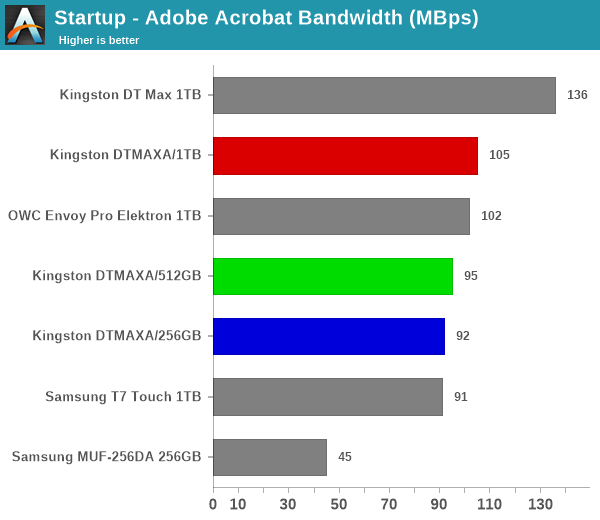
The DTMAXA drives perform reasonably well, making an appearance in the middle of the pack and without any suspiciously small scores. The DT Max Type-C and Type-A drives perform similarly, with the Type-C version enjoying a slight edge all through.
Office Workloads
The read-write bandwidth recorded for each drive in the exc and pow access traces are presented below.
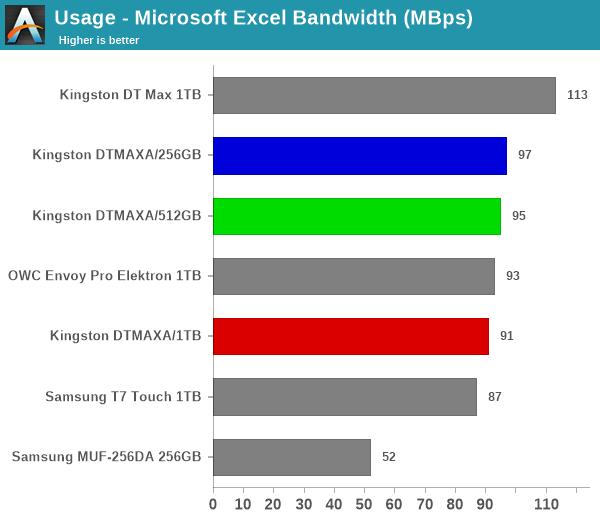
The DTMAXA series performs quite well given the use of a native UFD controller. However, the Type-C drive’s firmware / flash combination gives it the edge in office workloads.
Gaming Workloads
The read-write bandwidth recorded for each drive in the bf, cod, and ow access traces are presented below.
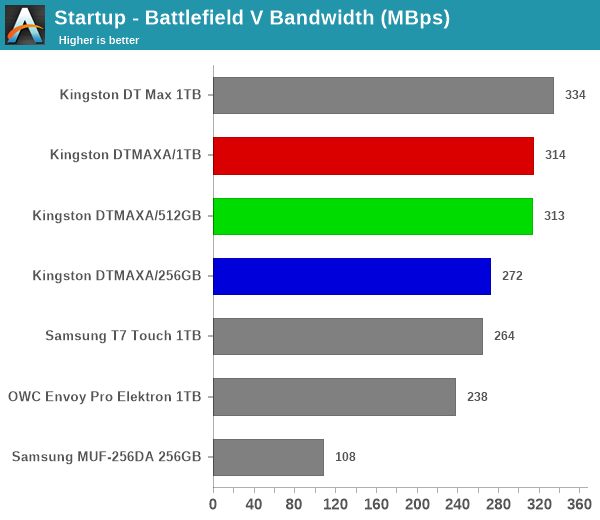
The read-intensive nature of gaming workloads are more in tune with the DT Max use-cases. Even though the DTMAXA SKUs appear in the top half, it is the Type-C UFD that enjoys a clear lead.
Files Transfer Workloads
The read-write bandwidth recorded for each drive in the cp1, cp2, cp3, cps1, cps2, and cps3 access traces are presented below.
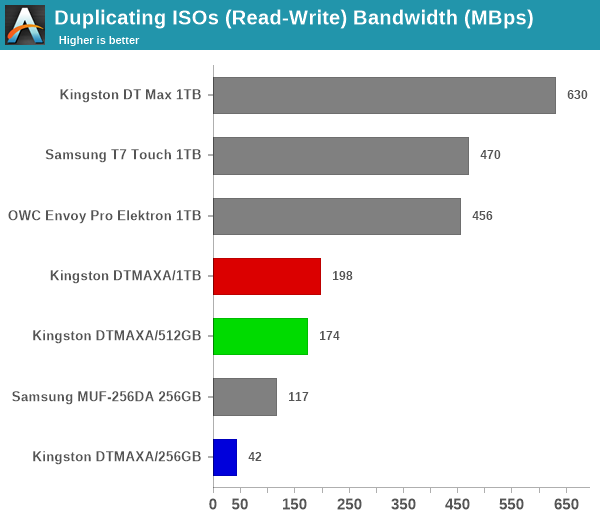
A combination of thermal throttling and SLC cache run-out throttling yields the above results for various SSDs. The trend is overall the same – the Type-C version outperforms the Type-A version. Read-centric workloads are welcome across the board by the DTMAXA series. On the write front, bridge-based SSDs as well as the Type-C DT Max 1TB enjoy a commanding lead.
Overall Scores
PCMark 10 reports an overall score based on the observed bandwidth and access times for the full workload set. The score, bandwidth, and average access latency for each of the drives are presented below.
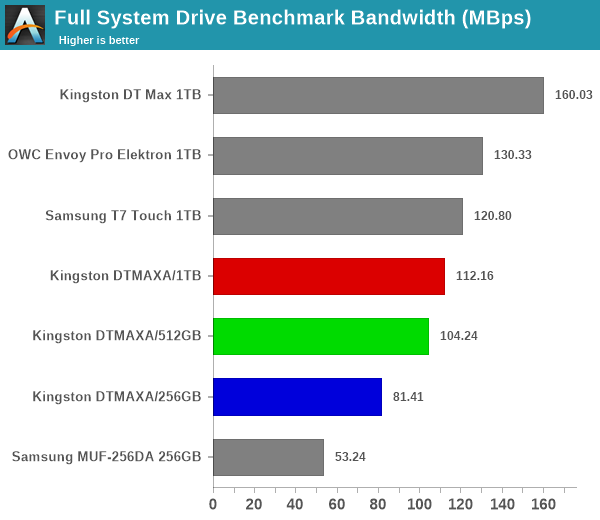
As expected, the DTMAXA series lands in the middle of the pack, with the 1TB outperforming the 512GB, and that in turn outperforms the 256GB SKU. The Type-C UFD emerges as the leader despite the presence of a couple of bridge-based SSD solutions in the mix. The new Type-A version is behind those, though
The performance of the UFDs and PSSDs in various real-world access traces as well as synthetic workloads was brought out in the preceding sections. We also looked at the performance consistency for these cases. Power users may also be interested in performance consistency under worst-case conditions, as well as UFD power consumption. The latter is also important when used with battery powered devices such as notebooks and smartphones. Pricing is also an important aspect. We analyze each of these in detail below.
Worst-Case Performance Consistency
Flash-based storage devices tend to slow down in unpredictable ways when subject to a large number of small-sized random writes. Many benchmarks use that scheme to pre-condition devices prior to the actual testing in order to get a worst-case representative number. Fortunately, such workloads are uncommon for direct-attached storage devices, where workloads are largely sequential in nature. Use of SLC caching as well as firmware caps to prevent overheating may cause drop in write speeds when a flash-based DAS device is subject to sustained sequential writes.
Our Sequential Writes Performance Consistency Test configures the device as a raw physical disk (after deleting configured volumes). A fio workload is set up to write sequential data to the raw drive with a block size of 128K and iodepth of 32 to cover 90% of the drive capacity. The internal temperature is recorded at either end of the workload, while the instantaneous write data rate and cumulative total write data amount are recorded at 1-second intervals.
| Sequential Writes to 90% Capacity – Performance Consistency | |
| TOP: | BOTTOM: |
 |
|
 |
|
The main comparison of interest is the DTMAXA/1TB against the Type-C DT Max 1TB SKU. While the Type-C version had up to 95GB of SLC cache, allowing it to consume that amount of data at 900 MBps+, the Type-A version is limited by the process queue depth / firmware to around 650 MBps. The sustained write also soon drops down into the 50 MBps range for both the Type-C and Type-A UFDs. However, there are many 400 MBps+ peaks in this scenario for the Type-A version. Nett effect is that even though the Type-C wins the quick initial write medal, the Type-A version finishes the workload significantly faster than the Type-C one (7410s vs. 10260s).
Power Consumption
Bus-powered devices can configure themselves to operate within the power delivery constraints of the host port. While Thunderbolt ports are guaranteed to supply up to 15W for client devices, USB 2.0 ports are guaranteed to deliver only 4.5W (900mA @ 5V). In this context, it is interesting to have a fine-grained look at the power consumption profile of the various external drives. Using the Plugable USBC-TKEY and a Type-C male to Type-A female adapter, the bus power consumption of the drives was tracked while processing the CrystalDiskMark workloads (separated by 5s intervals). The graphs below plot the instantaneous bus power consumption against time, while singling out the maximum and minimum power consumption numbers.
| CrystalDiskMark Workloads – Power Consumption | |
| TOP: | BOTTOM: |
 |
|
 |
|
The Type-A version idles at around 0.7W (but does possess deep-sleep characteristics). The peak power is 2.31W, compared to the idling / peak of 0.8W / 3.05W for the Type-C version.
Final Words
The Kingston DTMAXA SKUs are available for purchase today. The official prices are $180 for the 1TB, $106 for the 512GB, and $63 for the 256GB SKU. At these prices, the main competition is the OWC Envoy Pro Mini, priced at $179, $109, and $79 for the three corresponding capacities. The OWC product is made of aluminum, and sports both Type-A and Type-C connectors in the same SKU with a bit of ingenious industrial design. Dimensions are similar (slightly shorter length, but thicker), but the weight is almost doubled (one might argue that it lends it extra solidity). One of my complaints about the DT Max Type-C UFD after using it on and off is that it is too flimsy. The new DTMAXA is not fragile to that extent, but users would do well to handle the UFD with care (something that appears to be a bit less of a concern with the OWC Envoy Pro Mini). The performance numbers claimed by OWC are the same as that of the DT Max series. Given these aspects, to price the drives similarly would not make much sense. Thankfully, the street pricing seems to be a bit more sane, with CDW making the three SKUs available for $137, $80, and $47 respectively. At these prices, there is not much competition, and the DataTraveler Max series becomes much more easier to recommend.
The Kingston DataTraveler Max has enjoyed pole position in this market segment, with no competitor in sight for a few quarters now. As the situation is about to change, Kingston’s introduction of the Type-A SKUs will help in expanding the appeal of this high-performance product line. Though Kingston’s claims of the new Type-A drives having the same performance as last year’s Type-C drives (and thereby retaining the NVMe performance moniker) is not entirely false, last year’s Type-C version still delivers better real-world performance. The new behavior also makes the lack of a thermal solution less of an issue.
While the 512GB and 1TB SKUs perform as well as any portable SSD, the lowest capacity SKU (256GB) is fit for sparing use only – if the plan is to subject it to heavy workloads, the lower-priced Samsung MUF-256DA is a better bet despite its USB 3.2 Gen 1 interface (it can sustain 100 MBps under extreme load, compared to around 50 MBps for the DTMAXA/256GB).
The new DTMAXA series does fill in the market gap (a Type-A flash drive that can saturate the interface, similar to a portable SSD). With Type-C and Type-A USB ports set to co-exist in the market for many years to come, a dual-connector (Type-C + Type-A) version could be more appealing to power users dealing with multiple PCs simultaneously. We hope Kingston builds upon this platform and creates rugged UFDs as well to appeal to a broader audience.









